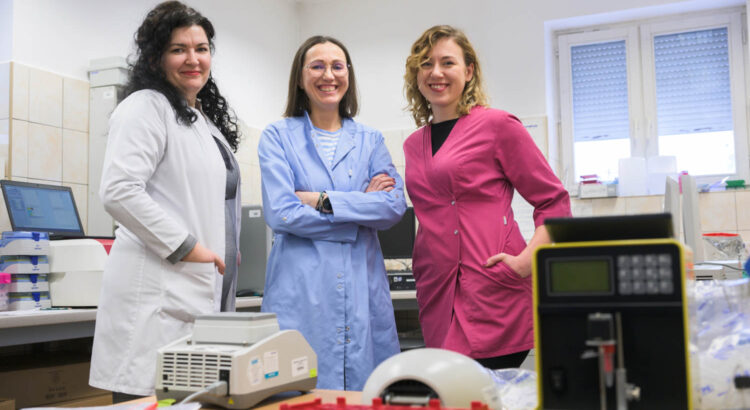One in ten turkeys may be affected by yellow semen syndrome that causes reduced fertilising ability. The molecular mechanisms of how this condition arises are not yet understood. The key might be a certain protein. Researchers at the Institute of Animal Reproduction and Food Research of the Polish Academy of Sciences in Olsztyn are investigating it as part of a project funded by the National Science Centre.
The protein in question is a soluble cysteine-rich scavenger receptor protein found in the semen of turkey.
– In mammals, this protein is a very interesting player in the immune system, among other things, it plays an important role in the recognition of microorganisms. Our hypothesis is that the scavenger receptor present in turkey semen is involved in the protection of semen against bacteria – emphasises the project leader Dr. Mariola Słowińska from the Department of Gamete and Embryo Biology of the IAR&FR PAS.
The researchers are also investigating whether this protein could be linked to the mechanism of yellow semen syndrome. – If the results are positive, knowledge of this could be used by breeders in the future to increase the efficiency of chick production by increasing the fertilisation efficiency of turkeys – the researcher adds.
LEARNING ABOUT A NEW PLAYER…
Little is known about the occurrence and role of the protein in focus (soluble cysteine-rich scavenger receptor) in birds.
– A few years ago, our research group was the first in the world to identify this protein in turkey semen. So far, all we know is that it is very similar to proteins of the scavenger receptor family found in mammals, which have the ability to bind to microorganisms and remove microorganisms or their own cells that have been damaged. They are found on the surface of cells of the immune system, e.g. on the surface of macrophages, which, after recognising bacteria or other microorganisms, absorb them (the process of phagocytosis) – explains the scientist, who studies bird reproduction, particularly in turkeys.
Based on this knowledge, scientists want to now study the aforementioned functions in birds. – First of all, we want to know the structure and biological functions of this protein. We have already succeeded in isolating the protein, i.e. obtaining its pure form. We will use this to analyse the physico-chemical properties and modifications of the protein. On this basis, we will create the first structural model of this protein for birds – explains Mariola Słowińska.
The next step will be to produce specific antibodies against the protein, which will allow the researchers, among other things, to localise the protein under study on cells of the immune system, sperm and in organs of the reproductive system. The researchers will examine whether the protein can be a potential marker, i.e. a factor confirming the presence of a particular disease, in this case, yellow semen syndrome. They also plan to learn more about the microbiome of turkey semen to see if the substrate for the development of yellow semen syndrome is a bacterial condition.
As the researcher points out, the project focuses, therefore, not only on learning more about the protein itself, but also provides a broader view on the reproductive and immune systems in birds.
… IN ORDER TO RAPIDLY DIAGNOSE THE DISEASE
Yellow semen syndrome in turkeys leads to disorders in the fertilising capacity of the semen. – Yellow semen contains more abnormal and immature spermatozoa and, in addition, their motility is impaired. On top of this, there is an increased activity of antioxidant enzymes, which indicates imbalance in the oxidative stress (the process in which free radicals attack body cells and cause damage to them) – explains Mariola Słowińska.
The only symptom of yellow semen syndrome in turkeys that is visible at a first glance is the slightly yellowish colour of the semen. However, as the scientist explains, in poultry production semen is collected from many males simultaneously, mixed, and only then is the artificial insemination (an assisted reproduction technique) carried out. – If there is some yellow semen in this pool, the sample will have a reduced fertilisation efficiency – clarifies Mariola Słowińska.
According to the scientific literature, approximately 10 percent of turkeys are affected by yellow semen syndrome.
– With our basic research, we want to deepen our knowledge of the immunology of bird semen, especially in the context of understanding the structure of the soluble cysteine-rich scavenger receptor and its role in the mechanism of yellow semen syndrome. We would also like to detect potential markers of this condition, which would allow rapid diagnosis of sick birds – concludes Mariola Słowińska.
—
The project entitled “Soluble scavenger receptor cysteine-rich domain-containing protein – SSc5D, a new player of innate immunity in turkey (Meleagris gallopavo) semen involved in yellow semen syndrome” is financed by the National Science Centre (NCN). The research is being conducted within a consortium formed by the Institute of Animal Reproduction and Food Research of the Polish Academy of Sciences in Olsztyn and the University of Agriculture in Kraków.
The research team includes: the staff of the Institute of Animal Reproduction and Food Research of the Polish Academy of Sciences in Olsztyn: Dr. Mariola Słowińska (Principal Investigator), Dr. Ewa Drzewiecka, Ewa Liszewska, MSc, Dr. Anna Szóstek-Mioduchowska, Halina Karol, Eng., Prof. Andrzej Ciereszko, and the staff of the University of Agriculture in Kraków: Dr. Laura Pardyak (coordinator on behalf of the URK), Dr. Zbigniew Arent, Dr. Artur Gurgul, Dr. Ewa Ocłoń, Dr. Tomasz Szmatoła, Dr. Igor Jasielczuk.
